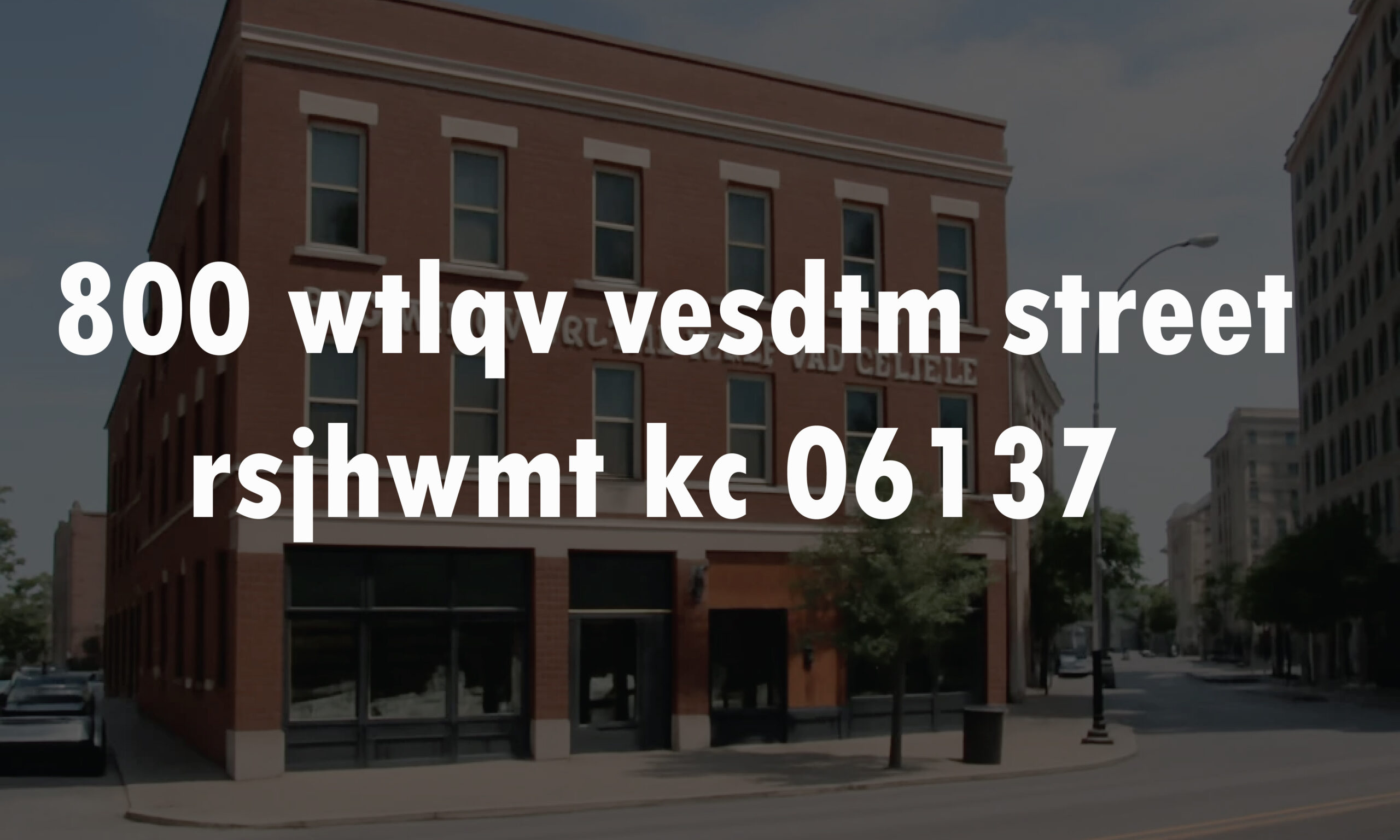Life Style
The Mystery of “800 wtlqv vesdtm street rsjhwmt kc 06137”: Unraveling the Internet’s Oddest Address

- Share
- Tweet /home/u433845138/domains/newsmm.co.uk/public_html/wp-content/plugins/mvp-social-buttons/mvp-social-buttons.php on line 71
https://newsmm.co.uk/wp-content/uploads/2025/06/BBBF55-01-1000x600.jpg&description=The Mystery of “800 wtlqv vesdtm street rsjhwmt kc 06137”: Unraveling the Internet’s Oddest Address', 'pinterestShare', 'width=750,height=350'); return false;" title="Pin This Post">
Have you ever stumbled upon something online that just doesn’t quite add up? A string of characters that looks like an address but makes absolutely no sense? If so, you might have recently encountered “800 WTLQV Vesdtm Street RSJHWMT KC 06137.” This peculiar phrase has been popping up in various corners of the internet, sparking curiosity and a good deal of head-scratching. Far from being a real place you can visit or send mail to, this alphanumeric jumble represents a fascinating dive into the quirks of our digital world.
In an age where information is readily available at our fingertips, finding something so seemingly unidentifiable can be genuinely intriguing. Is it a secret code? A test? Or perhaps just a very elaborate typo? Let’s embark on a journey to unravel the mystery behind “800 WTLQV Vesdtm Street RSJHWMT KC 06137” and understand why this odd string of characters has captured the attention of internet users.
The Emergence of an Enigma: Where Did it Come From?
The first crucial step in understanding “800 WTLQV Vesdtm Street RSJHWMT KC 06137” is to trace its origins. Unlike a genuine address that would be registered with a postal service or local government, this string doesn’t appear in any official databases or mapping services. Its recent surge in online visibility, particularly through articles from “Notos Technologies” in June 2025, suggests a relatively recent phenomenon. These articles, often sporting intriguing titles like “What’s Happening at 800 WTLQV Vesdtm Street RSJHWMT KC 06137? Unravel the Mystery,” point to a deliberate effort to highlight this string.

This recent appearance is a key indicator. If it were an old, forgotten address or a historical anomaly, we’d likely find traces of it in older archives or discussions. The sudden, contemporary focus strongly suggests its creation or propagation is a modern digital occurrence. It’s not the kind of organic discovery one might make digging through historical records; rather, it feels more like an intentional introduction into the online lexicon.
Deconstructing the “Address”: Why It’s Not a Real Place
Let’s break down why “800 WTLQV Vesdtm Street RSJHWMT KC 06137” fundamentally cannot be a genuine physical address.
Firstly, consider the structure. While it mimics certain elements of an address – a street number (“800”), a street name (“WTLQV Vesdtm Street”), and what appears to be a city/state/zip code combination (“RSJHWMT KC 06137”) – the individual components are nonsensical within the context of real-world addressing systems.
- “WTLQV Vesdtm Street”: Street names typically follow established naming conventions, often related to historical figures, local landmarks, or descriptive terms. “WTLQV Vesdtm” is a jumble of letters that doesn’t correspond to any known language or naming pattern for streets. It lacks the phonetic flow and recognizable structure of a genuine street name.
- “RSJHWMT KC 06137”: This portion is particularly telling. “KC” could theoretically stand for Kansas City, but the preceding “RSJHWMT” is entirely random. Furthermore, a genuine ZIP code (like 06137) would correspond to a specific geographic area, and when combined with “KC,” it would pinpoint a location within Kansas City. However, a quick search for “RSJHWMT” reveals no connection to any known city, county, or postal district. The presence of a legitimate-looking ZIP code (06137 is indeed a valid ZIP code for West Hartford, Connecticut) next to completely fabricated elements creates a deliberate juxtaposition that often characterizes digitally constructed “addresses.” It’s almost as if someone grabbed a real ZIP code and then randomly generated the rest of the surrounding information. This blend of real and fabricated elements is a common technique used in creating believable-looking, yet ultimately fake, data.
Secondly, a real address is inextricably linked to a physical location on a map. It has property lines, utility connections, and is recognized by postal services worldwide. If you tried to input “800 WTLQV Vesdtm Street RSJHWMT KC 06137” into Google Maps or any GPS system, it simply wouldn’t register as a valid destination. Postal services would deem it undeliverable. This lack of any tangible, real-world connection is the strongest evidence that we’re dealing with a construct, not a concrete place.
The Digital Undercurrent: Why Create a Nonsensical Address?
So, if it’s not a real place, why does it exist? The most plausible explanations for the creation and propagation of “800 WTLQV Vesdtm Street RSJHWMT KC 06137” lie within the digital realm.

- Clickbait and Engagement Generation: This is perhaps the most prominent theory, especially given the “Notos Technologies” articles. The human mind is inherently drawn to mysteries and inconsistencies. A title like “Unravel the Mystery of [Nonsensical Address]” is incredibly effective at grabbing attention in a crowded online space. People are curious; they want to know what this oddity is and why it’s appearing. By creating a seemingly legitimate yet ultimately fake address, content creators can generate significant traffic and engagement from curious users trying to figure it out. It’s a clever tactic to pique interest and drive clicks. The very nature of this string, being just on the edge of believable but ultimately absurd, makes it perfect for this purpose.
- Placeholder Text or Data Fodder: In the vast landscape of software development, database management, and web design, there’s often a need for placeholder data. Developers might use dummy addresses when testing forms, populating databases, or creating sample layouts. While Lorem Ipsum is standard for text, a randomly generated “address” serves a similar purpose for location-based fields. These placeholders can sometimes inadvertently escape into public view, or they might be intentionally used in a scenario where a real address isn’t necessary or desirable. For instance, if a system requires an address field but the information isn’t crucial for the user’s interaction, a nonsensical string prevents validation errors without needing a real location.
- Digital Puzzles or ARG (Alternate Reality Game) Elements: Less commonly, but still a possibility, such strings could be part of an online puzzle or an Alternate Reality Game (ARG). ARGs often weave narratives and challenges into the real world and digital spaces, using unconventional clues to guide players. A fake address could be a red herring, a piece of a larger code, or a breadcrumb leading to another clue. The random nature of the characters could even hint at an encryption method or a cipher. The recent surge in its appearance could, in this context, be tied to the launch or a new phase of an ARG.
- Testing and Cybersecurity: In cybersecurity, unusual strings of characters are sometimes used for testing purposes, such as identifying how systems handle malformed data inputs or to detect potential vulnerabilities. Similarly, they could be used in “honeypots” – decoy systems designed to lure and trap cyber attackers – where unusual data might signal an attempted intrusion. While this is a more technical application, it’s not entirely outside the realm of possibility for a generated string to be used in such a context.
The Broader Implications: What Does This Tell Us About the Internet?
The curious case of “800 WTLQV Vesdtm Street RSJHWMT KC 06137” isn’t just about a peculiar string of characters; it offers insights into the nature of the internet itself.
- The Power of Curiosity: The very existence of articles trying to “unravel the mystery” demonstrates the inherent human drive to understand and make sense of anomalies. The internet amplifies this curiosity, allowing shared puzzles and oddities to spread rapidly. When something doesn’t fit the expected pattern, people will seek explanations.
- The Proliferation of Generated Content: As AI and automation become more prevalent, the creation of synthetic data and content is on the rise. While “800 WTLQV Vesdtm Street” might not be directly AI-generated, it highlights how easily non-organic information can enter the digital bloodstream. This raises questions about verifying information and distinguishing between genuine and fabricated data.
- The Blurring Lines Between Real and Digital: In our increasingly digital lives, the lines between what is “real” and what exists solely online can sometimes blur. A string that looks like an address but isn’t, serves as a reminder that not everything encountered online has a real-world counterpart. Critical thinking and digital literacy are more important than ever.
- The Evolving Landscape of Information Dissemination: The way this string has gained traction, primarily through specific tech-focused articles, showcases how information (even fabricated information) can be deliberately introduced and disseminated online. It underscores the role of content creators and digital platforms in shaping what gains public attention.
Conclusion: A Digital Artifact of Our Time
“800 WTLQV Vesdtm Street RSJHWMT KC 06137” stands as a fascinating digital artifact. It’s not a secret government facility, a hidden treasure map, or a groundbreaking discovery. Instead, it’s a testament to the creative, sometimes mischievous, and often curious nature of the internet. Whether it was created for clickbait, as a functional placeholder, or as part of an elaborate digital game, its presence serves as a subtle reminder of the unique characteristics of our online world.
It encourages us to look a little closer, to question what we see, and to appreciate the intricate ways in which information, real or otherwise, travels and evolves in the vast digital ecosystem. So, the next time you encounter an address that just doesn’t sit right, remember “800 WTLQV Vesdtm Street” – the internet’s oddest, and perhaps most revealing, non-address. It’s a reminder that sometimes, the most interesting stories are found not in what something is, but in why it exists at all.
Frequently Asked Questions (FAQs)
1. Is “800 WTLQV Vesdtm Street RSJHWMT KC 06137” a real physical address? No, absolutely not. It is a fabricated string of characters that mimics the format of an address but does not correspond to any real-world location.
2. Why is this string of characters appearing online if it’s not real? It’s likely appearing online for several reasons, including: as clickbait to generate web traffic, as placeholder data in software development or databases, or potentially as a component of an online puzzle or Alternate Reality Game (ARG).
3. Can I send mail or packages to “800 WTLQV Vesdtm Street RSJHWMT KC 06137”? No, you cannot. Any mail or package sent to this string would be deemed undeliverable by postal services because it is not a valid address.
4. Is there any hidden meaning or secret code within “800 WTLQV Vesdtm Street RSJHWMT KC 06137”? While it’s possible it could be part of an ARG or puzzle, there’s no publicly known hidden meaning or secret code associated with this specific string. Its random nature suggests it’s likely a generated placeholder rather than an encrypted message.
5. How long has “800 WTLQV Vesdtm Street RSJHWMT KC 06137” been circulating online? Its recent prominent appearance, particularly in articles from June 2025 by “Notos Technologies,” suggests it’s a relatively recent phenomenon or has gained significant attention only recently.
6. Is “Notos Technologies” a reliable source for information about this address? “Notos Technologies” appears to be publishing articles about the string, often framed as a mystery. While they are a source of its propagation, the articles themselves are generally descriptive of the online phenomenon rather than authoritative on its origin as a real address.
7. Why would someone use a real ZIP code (like 06137) with a fake address? Using a real ZIP code alongside fabricated elements can make the fake address appear more convincing at first glance, even if the rest of the string is nonsensical. This adds to the “mystery” or gives it a veneer of authenticity for placeholder purposes.
8. Could this be related to a new online scam or phishing attempt? While the string itself isn’t inherently a scam, it’s crucial to be cautious. If you encounter this “address” in unsolicited emails, messages, or websites asking for personal information, it could be a component of a phishing attempt or a broader scam. Always verify the legitimacy of any unusual requests.
9. How can I verify if an address I find online is real or fake? You can verify an address by using reputable mapping services (like Google Maps, Apple Maps), postal service address lookups (like USPS for the US), or by cross-referencing with official property records if available. If an address doesn’t appear on these reliable sources, it’s likely fake.
10. What should I do if I keep encountering this “address” online? If you see it in a context that seems suspicious (e.g., a strange email or pop-up), it’s best to ignore it. If you’re simply seeing articles or discussions about it, you can treat it as an interesting internet anomaly, much like a viral meme or an urban legend of the digital age.
Click for more amazing info. News MM

-

 Celebrity8 months ago
Celebrity8 months agoIndia Rose Brittenham: All You Need to Know About Heather Thomas’ Daughter
-

 Celebrity8 months ago
Celebrity8 months agoMargot Rooker: All You Need to Know About Michael Rooker’s Wife
-

 Celebrity8 months ago
Celebrity8 months agoNadia Farmiga? All You Need to Know About Taissa Farmiga’s Sister
-

 Celebrity8 months ago
Celebrity8 months agoRobert Noah? All You Need to Know About Trevor Noah’s Father
-

 Celebrity7 months ago
Celebrity7 months agoJackie Witte? All You Need to Know About Paul Newman’s First Wife
-

 Celebrity8 months ago
Celebrity8 months agoCheryl Pistono? All You Need to Know About Kareem Abdul-Jabbar’s Ex-Girlfriend
-

 Celebrity8 months ago
Celebrity8 months agoAbigail S. Koppel? All You Need to Know About Leslie Wexner’s Wife
-

 Celebrity7 months ago
Celebrity7 months agoWho is the Father of Jay-Z? Biography of Adnis Reeves












